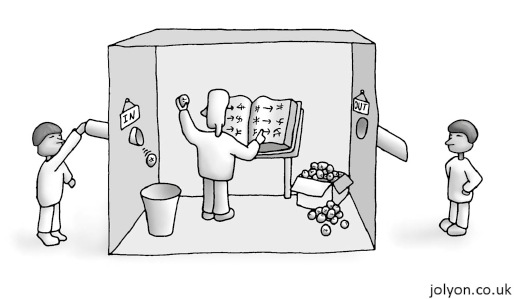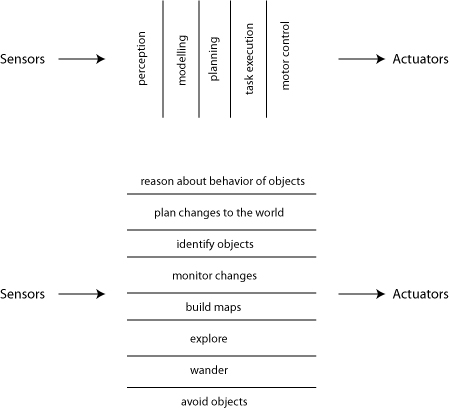
Intelligent Systems Techniques (MSc) and Knowledge and Reasoning (UG)
Chris Thornton
Introduction
The course teaches concepts, methods and issues of artificial
intelligence. Basic techniques are introduced for creating AI
applications in Java.
Instructions for lab sessions
Assessment is based on one programming assignment and an
unseen exam. Most of the syllabus material is in the online
lecture notes (below), but note-taking and additional reading
is strongly advised.
The first meeting for the course will be the first scheduled lecture.
The first lab will be the first uncancelled lab session. Depending on how lab
and lecture times interact, I will have to cancel one or more of the initial
sessions.
Lectures
Week 1
. Introduction to the field (pdf)
. Braitenberg Vehicles (pdf)
Week 2
. BugWorks tutorial.
. Route finding (pdf)
Week 3
. Problem Solving (pdf)
. Knowledge test (pdf)
Week 4
. Heuristic Search (pdf)
. Game Playing (pdf)
Week 5
. Knowledge Test (pdf)
. Debates briefing
Week 6
. Route finding in Java (pdf)
. Problem Solving in Java (pdf)
Week 7
. Heuristic Search in Java (pdf)
. Game Playing in Java (pdf)
Week 8
. Debate 1
. Epistemology (pdf)
Week 9
. Reasoning (pdf)
. First-order Logic (pdf)
Week 10
. Knowledge Test (pdf)
. Bayesian Reasoning (pdf)
Week 11
. Bayesian Networks (pdf)
. Debate 2
Week 12
. Revision
Assessment
Assessment is a programming assignment and an unseen exam, with a 50/50
credit split between the two. For the assignment due date, see Sussex Direct
The task is to construct a checkers (draughts) game in Java. The program should
present an interactive draughts board that allows pieces to be moved around as
per the rules of the game. (See http://www.indepthinfo.com/checkers/play.shtml
if you're unsure what these are.) It should be able to produce legal gameplay
at different levels of difficulty, making use of minimax and alpha-beta
pruning, as explained in the lectures in the first half of the term.
You can start work on this assignment as soon as you like but bear in mind that
the lectures on minimax and alpha-beta pruning are given around the middle of
term. Normally it will make sense to commence work after the lecture on minimax
in Java. This still leaves you plenty of time to complete the assignment.
There are 25, equally-weighted assessment criteria. In
developing your program, you should try to satisfy as
many of these as you can.
1. Interactive checkers gameplay (user v. AI) of some sort
2. Valid state representation
3. Successfor function of some sort
4. Valid successor function
5. Use of successor function for validating user moves
6. Use of successor function for generating AI moves
7. Rejection of invalid user moves, with explanation
8. Valid board display
9. Valid AI moves
10. Valid GUI board display
11. Interactive GUI display
12. Drag-and-drop user moves
13. Elements of minimax evaluation
14. Valid minimax evaluation
15. Forcing of takes
16. GUI shows completion of user move (with no pause)
17. King conversions
18. Multi-step user moves
19. Multi-step AI moves
20. GUI pauses to show intermediate states in multi-step moves
21. Minimax evaluation uses pruning of some sort
22. Minimax evaluation uses valid alpha-beta pruning
23. Variable level of AI (eg. a difficulty slider)
24. System accessible from web page (eg. applet)
25. Interactive tutorial guidance (eg. help button)
I use the lab sessions in the final two weeks of term to interactively assess
your work. So you need to be ready from the second to last week to give me a
short (3-4 minute) demo. I'll use this to establish which criteria you've met,
and also to confirm that the code you demo is your own work.
If it's not possible for me to see all the demos in lab time, I'll
arrange extra sessions as needed. The demo is mainly to enable me to
assess your work. However, students in the same lab session are invited
to watch demos too.
As well as providing the demo, you should submit the text of your code (all
source and class files) electronically through Study Direct. The source code
you submit online will be used to resolve any ambiguities concerning which
criteria you've met. Note the code you submit must be the code used for your
demo. All university rules on plagiarism apply.
Extra feedback
If you would like further feedback on the way in which you've coded the
checkers game (beyond the feedback sheet on Study Direct), you are invited to
come to see me on a 1-to-1 basis on the first day of the following term. (My
office is C1-101, internal phone 8856). Email me for an appointment or turn up
sometime on the first day of term. Remember to print out your code and bring it
with you when you come.
Course texts
The back-up text for the course is the (encyclopedic) book by Russell
and Norvig, now in third edition.
Russell and Norvig, `Artificial Intelligence: A Modern Approach.'
(There are many copies in the main
library and one in the department library.)
Also of interest is this AI-in-Java text:
Bigus and Bigus, `Constructing Intelligent Agents in Java.' (6
copies in the library including one in reserve section. I also hope
to arrange for the COGS library to buy a copy.)
For something lighter, try
`Hal's Legacy' edited by David G. Stork. This provides a
light-hearted overview of the state-of-the-art in AI.
Programming issues
The assignment involves programming so if you're having troubles in
this area, it's a good idea to take action earlier rather than later.
The key rule is to make yourself do all the lab exercises (even the
ones that seem trivial).
I don't require you to follow any particular programming genre or
style, i.e., it doesn't have to be pure `OOP'. However, you do need to
be consistent, and follow the general principles of good programming.
These are as follows.
- modularity: modular programs are made up from small, independent
components (typically methods) that can be tested and debugged
independently from the rest of the program. Such components get their
data via formal input parameters. They only affect the rest of the
program via the formal outputs (results) they return. They are like
`black boxes' which, once validated, can be ignored. Modular programs
make little or no use of class variables for communication information
from one part of the program to another. Writing your program in a
modular way is a divide-and-conquer strategy.
- simplicity: don't introduce complications unless there is a real
need. Don't start experimenting with advanced features of Java (e.g.
final variables and inner classes) without good reason. If you find you
are writing the same (or almost the same) code more than once, look for
a way to get rid of the redundancy. You'll probably need to create a
new method or class which can be used in different situations.
- transparency: choose your variable and method names so as to make the
code self-explanatory, as far as possible. The name of a variable or
method needs to describe the role it plays. Resort to inline comments
when you are unable to find a way of making the code `tell its story'.
If you do use inline comments, keep them short, and format them so as
to minimise disruption to the visual structure of the code. Don't let
line-wrapping obscure indentation.
- presentation: the program should be presented neatly
and clearly, using consistent conventions for use of
blank-lines etc. Indentation should be consistently used
to show the logical structure of the program,
particularly the presence of constructs like `if'
statements and loops. Programs should be commented in
the standard `javadoc' style but please note that the
javadoc listing should NOT be included with your
submission.
Debate arrangements
Historically, there have been two huge debates in AI: one focussing on
John Searle's `chinese room', the other focussing on Rodney Brooks'
`knowledge bottleneck'. We will use a couple of sessions to have a go at
resolving these.
The basic arrangements are as follows.
At the debate briefing, students will be divided up into four groups (A,
B, C and D). Group A will be delegated to argue the pro-Searle cawse,
and group B to argue the anti-Searle case. Group C will be delegated to
be pro-Brooks, and group D anti-Brooks.
The first debate is around week 8. The second is whenever I finish the
material, e.g., week 11. In the weeks running up to the debates,
students read up on relevant sources and prepare notes to enable them to
argue their case as strongly as possible.
At each debate, we randomly select one person from the two relevant
groups to make a five-minute opening statement. After these have been
made, the debate is opened up to the whole group. At the end of the
session, we take a vote to decide which side has won.
First debate
The chinese room

Motion
- The chinese room argument proves that AI systems do not really
understand anything.
The original publication is Searle's BBS article, which includes
multiple commentaries.
- Searle, J. (1980). Minds, brains and programs. Behavioral and Brain
Sciences, No. 3 (pp. 417-57).
There are hundreds publications of relevance here, and a huge number of
web articles and videos which you can google. An
easy-to-read article summarizing Searle's
main argument is here.
In putting forward the chinese-room argument, Searle was reacting to
natural-language systems such as SHRDLU, see this).
Readings largely in favour
- Lucas, J. (1964). Minds, machines and godel. In A. Anderson
(Ed.), MINDS AND MACHINES (pp. 43-59). New Jersea: Prentice Hall.
- Dreyfus, H. (1981). From micro-worlds to knowledge
representation: AI at an impasse. In J. Haugeland (Ed.), MIND
DESIGN: PHILOSOPHY, PSYCHOLOGY, ARTIFICIAL INTELLIGENCE (pp.
161-219). Cambridge, Mass.: MIT Press.
- Penrose, R. (1989). THE EMPEROR'S NEW MIND: CONCERNING
COMPUTERS, MINDS, AND THE LAWS OF PHYSICS. Oxford University
Press. (particualrly chaps 1 & 2)
- Nagel, T. (1981). What is it like to be a bat?. In D.R.
Hofstadter and D.C. Dennett (Eds.), THE MIND'S I. Basic Books.
Readings largely against
- Turing, A. (1964). Computing machinery and intelligence. In A.R.
Anderson (Ed.), MINDS AND MACHINES (pp. 4-30).
- Hofstadter, D. and Dennett, D. (1981). Reflections on searle's
chinese room argument. In D.R. Hofstadter and D.C. Dennett (Eds.),
THE MIND'S I (pp. 373-382). Basic Books.
- Boden, M. (1990). Escaping from the chinese room. In M.A. Boden
(Ed.), THE PHILOSOPHY OF ARTIFICIAL INTELLIGENCE (pp. 89-104).
Oxford University Press.
- Gregory, R. (1987). In defence of artificial intelligence - a
reply to john searle. In C. Blakemore and S. Greenfield (Eds.),
MINDWAVES (pp. 235-247). Blackwell.
- Feigenbaum, E. and McCorduck, P. (1984). THE FIFTH GENERATION.
London: Pan Ltd.
Below are some alternative sources for the readings above. Note
that any book which contains Searle's paper is very likely to
contain other articles of relevance.
- Turing, A. (1950). Computing machinery and intelligence. MIND,
No. 59 (pp. 433-460).
- Dreyfus, H. (1985). From micro-worlds to knowledge
representation: AI at an impasse. In R.J. Brachman and H.J.
Levesque (Eds.), READINGS IN KNOWLEDGE REPRESENTATION (pp. 71-94).
Los Altos: Morgan Kaufmann.
- Searle, J. (1990). Minds, brains and programs. In M.A. Boden
(Ed.), THE PHILOSOPHY OF ARTIFICIAL INTELLIGENCE (pp. 67-88).
Oxford University Press.
- Searle, J. (1984). MINDS, BRAINS AND SCIENCE: THE 1984 REITH
LECTURES. London: BBC Publications.
- Searle, J. (1987). Minds and brains without programs. In C.
Blakemore and S. Greenfield (Eds.), MINDWAVES (pp. 209-233).
Blackwell.
- Searle, J. (1981). Minds, brains and programs. In J. Haugeland
(Ed.), MIND DESIGN: PHILOSOPHY, PSYCHOLOGY, ARTIFICIAL
INTELLIGENCE (pp. 282-306). Cambridge, Mass.: MIT Press.
- Searle, J. (1981). Minds, brains and programs. In D.R.
Hofstadter and D.C. Dennett (Eds.), THE MIND'S I (pp. 353-372).
Basic Books.
- Penrose, R. (1987). Minds, machines and mathematics. In C.
Blakemore and S. Greenfield (Eds.), MINDWAVES (pp. 259-278).
Blackwell.
Second debate
Motion
- Since explicit knowledge representation produces an
information bottleneck, it is only appropriate for use in toy
domains.
The key article for this debate is Brooks' paper `Intelligence without
Representation'.
- Brooks, R. (1991). Intelligence without representation. ARTIFICIAL
INTELLIGENCE, 47 (pp. 139-159). Available here.
For information on the subsumption architectures and the
information bottleneck see
- Brooks, R, (1985) A Robust Layered Control System for a Mobile Robot.
AI Memo 864, MIT AI Lab. Available here.
There's also a nice powerpoint presentation on Brooks' views:
here.
Again, you'll find a huge number of web articles and videos offering all
shades of opinion. But beware that where stuff is not peer-reviewed,
there is no guarantee of valiidity.
Readings largely in favour
- Braitenberg, V. (1984). VEHICLES: EXPERIMENTS IN SYNTHETIC
PSYCHOLOGY. London: The MIT Press.
- Cliff, D., Husbands, P. and Harvey, I. (1993). Evolving visually
guided robots. In J. Meyer, H. Roitblat and S. Wilson (Eds.), FROM
ANIMALS TO ANIMATS: PROCEEDINGS OF THE SECOND INTERNATIONAL
CONFERENCE ON SIMULATION OF ADAPTIVE BEHAVIOUR (SAB92).
MIT/Bradford Books. Available as
ftp://ftp.informatics.sussex.ac.uk/pub/reports/csrp/csrp220.ps
- Wheeler, M. (1996). From robots to rothko: the bringing forth of
worlds. In M.A. Boden (Ed.), THE PHILOSOPHY OF ARTIFICIAL LIFE
(pp. 209-236). Oxford: Oxford University Press.
- van Gelder, T. (1992). What might cognition be if not
computation?. Research Report 75, Bloomington, IN47405: Cognitive
Science, Indiana University (Indiana).
Readings largely against
- Kirsh, D. (1996). Today the earwig, tomorrow man?. In M.A. Boden
(Ed.), THE PHILOSOPHY OF ARTIFICIAL LIFE (pp. 237-261). Oxford
University Press.
- Lenat, D. and Feigenbaum, E. (1992). On the thresholds of
knowledge. In D. Kirsh (Ed.), FOUNDATIONS OF ARTIFICIAL
INTELLIGENCE (pp. 185-250). Amsterdam: MIT Press.
- Nilsson, N. (1992). Logic and articial intelligence. In D. Kirsh
(Ed.), FOUNDATIONS OF ARTIFICIAL INTELLIGENCE (pp. 31-56).
Amsterdam: MIT Press.
- Newell, A. (1980). The knowledge level: presidential address.
AAAI80. Stanford: American Association for Artificial
Intelligence. Also available as
http://www.aaai.org/AITopics/assets/PDF/AIMag02-02-001.pdf
Readings with various viewpoints
- Clark, A. and Toribio, J. (1994). Doing without representing?.
CSRP 310, Cognitive and Computing Sciences, University of Sussex,
UK. Available as www.cogs.indiana.edu/andy/DoingW-O-rep.pdf
Misc.
- Brooks, R. and Steels, L. (Eds.) (1994). THE `ARTIFICIAL LIFE'
ROUTE TO `ARTIFICIAL INTELLIGENCE'. Hillsdale, NJ: Erlbaum.
- Brooks, R. and Stein, L. (1994). Building brains for bodies.
ROBOTICS AND AUTONOMOUS SYSTEMS, aim 1439, 1, No. 1 (pp. 7-25).
The bottleneck diagram




